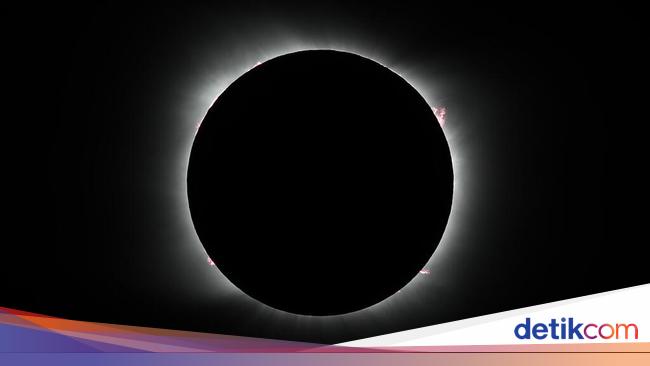Jakarta –
By calendar astronomy November released by the National Institute of Aeronautics and Space Research Center for Space Research (EIGHT) – BRIN, there are some celestial phenomena worth waiting for.
Like November, December is studded with meteor showers. This month there is a total solar eclipse, can Indonesia see it? The following is a summary as quoted from detikINET from the LAPAN Science Education site.
December 3 – Moon meets Mars
While some regions of the world witnessed the occultation of Mars by the Moon (as Mars passed behind the Moon), regions that did not get to see it phenomenon conjunction between the Moon and the Red Planet. This phenomenon occurred on December 3 and will be seen at 07.28 am local time.
This phenomenon can already be seen on the eastern horizon, 1 hour before sunrise for 35 minutes. At that time, the Moon was in the final crescent phase with an illumination of 2.7%. The position of Mars is at a magnitude of +5.4, and these conjunctions are separated at an angle of 1.3-1.6 degrees.
December 4 – Super new moon
When the new Moon phase occurs close to the perigee of the Moon, there is a super new moon or super new moon. This is an annual astronomical phenomenon. The last super new moon occurred on October 17, 2020, the next super new moon will occur in 2023, 2024, and 2025.
On the December 4 super new moon, the new Moon occurred at 02:43 noon local time, and the Moon was at a geocentric distance of 356,805 kilometers and an angular width of 33.49 arc minutes. At 4:57 p.m. local time, the Moon’s perigee occurred at a geocentric distance of 356,796 kilometers and an angular width of 33.49 arc minutes.
December 4 – Total Solar Eclipse
It’s still on December 4th phenomenon total solar eclipse. The Antarctic region can witness this special phenomenon, because the Antarctic region is exposed to the Moon’s umbra. While Antarctica goes through a total phase, these regions experience a partial solar eclipse:
The width of the eclipse is less than 10% of the diameter of the Sun:
- south Africa
- Namibia
- southern Australia
The width of the eclipse is 10-40% of the diameter of the Sun:
- Malvinas Islands
- Kepulauan Tierra del Fuego
The width of the eclipse is 93-97% the diameter of the Sun
- South Georgia
- South Sandwich Islands
Beginning at 10:59 a.m. local time, the solar eclipse will be full at 12:30 p.m. local time and reach its maximum phase at 01.03 p.m. local time. At 3:07 p.m., the total solar eclipse will end. The total duration ranges from 90-116 seconds.
Unfortunately, Indonesia can’t watch phenomenon this. According to Pussainsa LAPAN, this total solar eclipse is the 13th of 70 eclipses of the 152nd Saros Series. Furthermore, this phenomenon will occur again in mid-December 2039 and towards the end of December 2057.
December 6-7 – Peak of the Phenicid meteor shower
The meteor shower in December 2021 will be opened by the Phenicid meteor shower. Reaching its peak on December 6-7, this meteor shower occurs in the constellation Phoenix and is the dust residue of Comet 289P/Blanpain. This phenomenon can be seen from early twilight on December 6 to 02:15 in the morning on December 7 local time.
Pussainsa LAPAN predicts meteors will fall with an intensity of 51 meteors/hour in Sabang to 74 meteors/hour on Rote Island. When at the peak / zenith, the Phenicid meteor shower descends with 100 meteors per hour. To be able to see it, the sky must be clear without light pollution and the field of view spreads out without obstructions.
December 7-8 – Puppid-Velid . meteor shower
As the name suggests, this meteor shower occurs in the constellation Vela which borders the constellation Puppis. Appeared on December 1-15, the Puppid-Velid meteor shower peaked on December 7-8, this meteor shower is the dust remnant of Comet 96P/Machholz.
The intensity of the Puppid-Velid meteor shower is around 6 meteors/hour for the Sabang area and 8 meteors/hour for Rote Island. At the zenith, intensity peaks at 10 meteors/hour. This phenomenon was seen from December 7 at 9 pm local time until the end of the sea dawn (25 minutes before sunrise) on December 8 local time.
December 9-10 – Peak of the Monocerotid meteor shower
The peak of the Monocerotid meteor shower occurs in the constellation Monoceros. This meteor shower is the production of dust residue from asteroid 2004 TG10 (which also caused the northern Taurid meteor shower).
This phenomenon can be witnessed on December 9 at 07.40 pm local time until December 10 at the end of the dawn of the sea. This meteor shower will fall with an intensity of 1.9-2 meteors / hour.
Watch Videos “4 Astronomical Phenomena in Early October, Meteor Showers!“
[Gambas:Video 20detik]
– .


